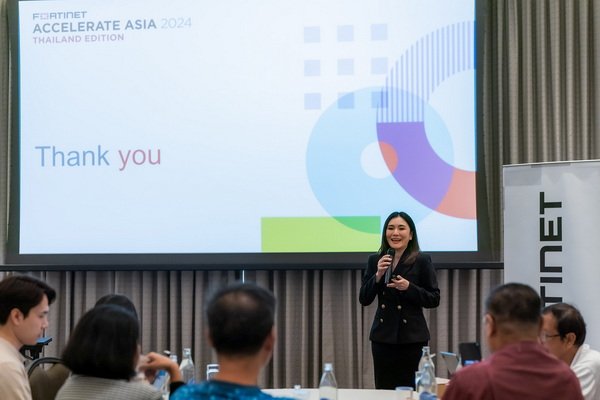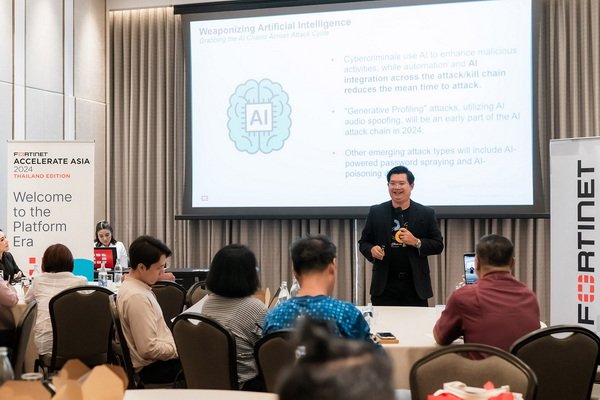รายงาน Global Threat Landscape สำหรับครึ่งหลังของปี 2023 จาก FortiGuard Labs ย้ำว่าผู้จำหน่ายต้องยึดแนวปฏิบัติที่ดีที่สุดในการเปิดเผยช่องโหว่ด้านความปลอดภัย เพื่อช่วยให้องค์กรใช้แนวทางและหลักปฏิบัติด้าน ไซเบอร์ ไฮจีน ได้ดียิ่งขึ้น พร้อมบริหารจัดการแพตซ์ได้ดีขึ้น
เดเรค แมนคีย์ ประธานฝ่ายกลยุทธ์ด้านความปลอดภัย และรองประธานอาวุโสฝ่ายข่าวกรองภัยคุกคามระดับโลก FortiGuard Labs กล่าวว่า “รายงาน Global Threat Landscape Report ในครึ่งหลังของปี 2023 จาก FortiGuard Labs” ชี้ให้เห็นว่าผู้คุกคามสามารถใช้ประโยชน์จากช่องโหว่ความปลอดภัยใหม่ที่ถูกเปิดเผยได้รวดเร็วขนาดไหน โดยในสภาพการณ์เช่นนี้ ทั้งผู้จำหน่ายและลูกค้าต่างมีบทบาทที่ต้องรับผิดชอบ ในมุมของผู้จำหน่ายต้องมีการตรวจสอบความปลอดภัยอย่างเข้มงวดในทุกขั้นตอนการพัฒนาผลิตภัณฑ์ และทุ่มเทเพื่อรับผิดชอบเกี่ยวกับความโปร่งใสอย่างตรงไปตรงมาในการเปิดเผยช่องโหว่ด้านความปลอดภัย จากที่ NIST ชี้ให้เห็นว่าในปี 2023 มีช่องโหว่มากกว่า 26,447 รายการจากผู้จำหน่ายทั้งหมด จึงจำเป็นอย่างยิ่งที่ลูกค้าต้องมีการอัปเดตแพตช์อย่างเข้มงวด เพื่อลดความเสี่ยงจากการถูกโจมตี”
ฟอร์ติเน็ต ผู้นำด้านความปลอดภัยทางไซเบอร์ระดับโลกที่ขับเคลื่อนการผสานรวมของระบบเน็ตเวิร์กกิ้งและซีเคียวริตี้ เผยผลรายงาน Global Threat Landscape Report ในช่วงครึ่งหลังของปี 2023 จาก FortiGuard Labs โดยรายงานฉบับล่าสุดสำหรับครึ่งปีหลัง จะให้ภาพรวมสถานการณ์ภัยคุกคามปัจจุบัน รวมถึงแนวโน้มที่น่าจับตามองตั้งแต่ช่วงเดือนกรกฏาคม ถึงธันวาคม 2023 และการวิเคราะห์ความเร็วที่ผู้โจมตีทางไซเบอร์ใช้ประโยชน์จากช่องโหว่ใหม่ที่ถูกค้นพบทั่วทั้งอุตสาหกรรมความปลอดภัยทางไซเบอร์ และการเพิ่มขึ้นของแรนซัมแวร์ที่เจาะจงเป้าหมายและกิจกรรมของมัลแวร์แบบไวเปอร์ ที่มุ่งทำลายข้อมูลในภาค OT และภาคอุตสาหกรรม

ประเด็นสำคัญที่พบในช่วงครึ่งหลังของปี 2023
– การโจมตีเกิดขึ้นโดยเฉลี่ย 4.76 วันหลังจากมีการเปิดเผยช่องโหว่ใหม่สู่สาธารณะ เช่นเดียวกับรายงาน Global Threat Landscape ในช่วงครึ่งแรกของปี 2566 ของ FortiGuard Labs ที่พยายามหาว่าตั้งแต่เริ่มมีการเปิดเผยช่องโหว่ (Vulnerabilities) จนถึงการนำช่องโหว่ไปใช้โจมตี (Exploitation) ใช้เวลานานแค่ไหน หรือช่องโหว่ที่มีคะแนนความเสี่ยงสูง (EPSS – Exploit Prediction Scoring System) จะถูกโจมตีได้เร็วขึ้นหรือไม่ และจะสามารถคาดการณ์ระยะเวลาเฉลี่ยที่ช่องโหว่จะถูกโจมตีโดยใช้ข้อมูลจาก EPSS ได้หรือไม่ ซึ่งจากการวิเคราะห์ พบว่าครึ่งหลังของปี 2023 ผู้โจมตีสามารถนำช่องโหว่ใหม่ๆ ที่มีการเปิดเผย ไปใช้โจมตีได้เร็วขึ้นถึง 43% เมื่อเทียบกับครึ่งแรกของปี 2023 เหตุการณ์ดังกล่าวแสดงให้เห็นว่า ผู้จำหน่ายจะต้องทุ่มเทอย่างจริงจังเพื่อค้นหาช่องโหว่ในผลิตภัณฑ์ของตัวเอง และพัฒนาแก้ไขให้ได้ก่อนที่จะถูกโจมตีจริง (เพื่อลดกรณีการเกิดของช่องโหว่แบบซีโร่-เดย์) นอกจากนี้ รายงานยังเน้นย้ำว่าผู้จำหน่ายต้องเปิดเผยข้อมูลช่องโหว่ให้ลูกค้ารับทราบล่วงหน้าด้วยความรวดเร็วและโปร่งใส เพื่อให้แน่ใจว่าลูกค้ามีข้อมูลที่จำเป็นสำหรับป้องกันสินทรัพย์ของตนได้อย่างมีประสิทธิภาพ ก่อนที่ผู้โจมตีทางไซเบอร์จะสามารถโจมตีช่องโหว่นั้น (N-day Vulnerabilities)
– ยังมีช่องโหว่ N-Day บางตัวที่ไม่ได้รับการแก้ไขแพตช์ (unpatched) นานเกิน 15 ปี ไม่ใช่แค่ช่องโหว่ที่เพิ่งระบุได้เท่านั้นที่ทำให้ CISOs และทีมดูแลด้านความปลอดภัยต้องกังวล จากการติดตามและเก็บข้อมูลของฟอร์ติเน็ต (Fortinet Telemetry) พบว่า 41% ขององค์กรตรวจพบการเจาะระบบจากลายเซ็น หรือ Signatures ที่มีอายุน้อยกว่าหนึ่งเดือน และเกือบทุกองค์กร (98%) ตรวจพบช่องโหว่ N-Day ที่อยู่ในระบบเป็นเวลาอย่างน้อย 5 ปี นอกจากนี้ FortiGuard Labs ยังคงพบผู้โจมตีที่ใช้ช่องโหว่ที่มีอายุเกิน 15 ปีในการโจมตี ยิ่งเป็นการย้ำถึงความจำเป็นในการเฝ้าระวังความปลอดภัยอย่างต่อเนื่อง อีกทั้งกระตุ้นให้องค์กรต่างๆ รีบดำเนินการอย่างรวดเร็ว ด้วยการแก้แพตช์พร้อมอัปเดตโปรแกรมอย่างสม่ำเสมอ โดยใช้แนวปฏิบัติที่ดีที่สุดและคำแนะนำจากองค์กรต่างๆ เช่น Network Resilience Coalition เพื่อสร้างความปลอดภัยให้เครือข่ายโดยรวมได้มีประสิทธิภาพยิ่งขึ้น
– ช่องโหว่บนอุปกรณ์ปลายทาง (Endpoint) ที่รู้จักกันดี โดนโจมตีน้อยกว่า 9% ในปี 2022 FortiGuard Labs ได้เปิดเผยแนวคิดของ “Red Zone” ซึ่งช่วยให้ผู้อ่านเข้าใจได้ดีขึ้นว่าผู้โจมตีมีแนวโน้มที่จะใช้ช่องโหว่เฉพาะเจาะจงใดบ้างเพื่อการโจมตี เพื่อให้เห็นภาพ รายงาน Global Threat Landscape สามฉบับล่าสุดได้ตรวจสอบจำนวนช่องโหว่ทั้งหมด โดยมุ่งเป้าที่อุปกรณ์ปลายทาง โดยในช่วงครึ่งหลังของปี 2023 การวิจัยพบว่า 0.7% ของช่องโหว่และช่องทางการโจมตีที่เป็นที่รู้จักในระบบคอมพิวเตอร์และเครือข่ายทั้งหมด (CVEs: Common Vulnerabilities and Exposures) ที่พบในอุปกรณ์ปลายทางกำลังโดนโจมตี ซึ่งแสดงให้เห็นว่าพื้นที่การโจมตีมีขนาดเล็กลงมาก ทำให้ทีมรักษาความปลอดภัยสามารถมุ่งเน้นและให้ความสำคัญในการแก้ไขได้ก่อน
– 44% ของตัวอย่างแรนซัมแวร์ และมัลแวร์ ไวเปอร์ ทั้งหมดต่างมุ่งเป้าไปที่ภาคอุตสาหกรรม เซนเซอร์ทั้งหมดของฟอร์ติเน็ต มีการตรวจพบแรนซัมแวร์ลดลงถึง 70% เมื่อเทียบกับช่วงครึ่งแรกของปี 2023 การชะลอตัวของแรนซัมแวร์ ที่สังเกตได้ในปีที่ผ่านมา สามารถอธิบายได้ว่าเป็นเพราะผู้โจมตีเปลี่ยนกลยุทธ์จากการส่งมัลแวร์แบบสุ่ม (Spray and Pray) ด้วยวิธีเดิมๆ เป็นการโจมตีแบบมุ่งเป้ามากขึ้น โดยส่วนใหญ่เน้นที่อุตสาหกรรมหลัก ทั้งภาคพลังงาน เฮลธ์แคร์ การผลิต การขนส่งและโลจิสติกส์ ตลอดจนยานยนต์
– บอทเน็ตมีความยืดหยุ่นอย่างไม่น่าเชื่อ หลังตรวจพบครั้งแรก ใช้เวลาเฉลี่ยถึง 85 วันจึงจะหยุดการสื่อสารเพื่อออกคำสั่งและควบคุมมัลแวร์ได้ (C2) ในขณะที่บอททราฟฟิก ยังอยู่ในระดับคงที่เมื่อเทียบกับครึ่งแรกของปี 2023 โดย FortiGuard Labs ยังคงเห็นบอทเน็ตซึ่งเป็นที่รู้จักกันดีเพิ่มขึ้นในช่วงสองสามปีที่ผ่านมา เช่น Gh0st, Mirai, และ ZeroAccess แต่ก็มีบอทเน็ตใหม่ 3 ตัวปรากฏขึ้นในช่วงครึ่งหลังของปี 2023 ได้แก่ AndroxGh0st, Prometei, และ DarkGate
– เป็นที่สังเกตุว่ากลุ่มภัยคุกคามขั้นสูง หรือ Advanced Persistent Threat (APT) จำนวน 38 กลุ่มจาก 143 กลุ่มที่ระบุโดย MITRE ยังมีการเคลื่อนไหวอยู่ในช่วงครึ่งหลังของปี 2023 โดย FortiRecon ซึ่งเป็นบริการป้องกันความเสี่ยงทางดิจิทัลของฟอร์ติเน็ต ระบุว่ากลุ่มภัยคุกคาม 38 ใน 143 กลุ่มที่ MITRE ติดตามมีการเคลื่อนไหวในช่วงครึ่งหลังของปี 2023 โดยจากทั้งหมด Lazarus Group, Kimusky, APT28, APT29, Andariel, และ OilRig คือกลุ่มที่เคลื่อนไหวมากที่สุด ด้วยธรรมชาติของ APT และกลุ่มไซเบอร์ของภาครัฐ จะเน้นแคมเปญสั้นๆ และเจาะจง เมื่อเทียบกับอาชญากรไซเบอร์ที่ใช้แคมเปญโจมตียาวๆ จึงจำเป็นที่ FortiGuard Labs จะต้องติดตามทั้งวิวัฒนาการและปริมาณการโจมตีอย่างต่อเนื่อง

การสนทนาบนเว็บมืด (Dark Web Discourse) รายงาน Global Threat Landscape Report ในช่วงครึ่งหลังของปี 2023 จาก FortiRecon ให้ภาพรวมการสนทนาระหว่างผู้ก่อการคุกคามในฟอรัมบนเว็บมืด มาร์เก็ตเพลส ช่องทาง Telegram ซึ่งเป็นแอปพลิเคชันที่เผยแพร่ข้อมูลให้กับผู้ติดตามจำนวนมาก รวมถึงแหล่งข้อมูลอื่นๆ โดยข้อมูลที่พบมีดังต่อไปนี้
– ผู้ก่อการคุกคามมักพูดคุยโดยพุ่งเป้าไปที่องค์กรภาคการเงินมากที่สุด ตามด้วยภาคธุรกิจบริการและภาคการศึกษา
– มีการรั่วไหลของข้อมูลส่วนบุคคลที่ถูกแชร์ไปตามฟอรัมดังๆ บนเว็บมืดมากกว่า 3,000 ครั้ง
– มีการพูดคุยถึงช่องโหว่ 221 รายการอย่างจริงจังบนเว็บมืด (Darknet) อีกทั้งมีถกประเด็นเกี่ยวกับช่องโหว่ 237 รายการในช่องทาง Telegram
– บัตรชำระเงิน (Payment Cards) กว่า 850,000 ใบ ถูกนำมาประกาศขาย
การพลิกสถานการณ์เพื่อต้านอาชญากรรมทางไซเบอร์ ประเด็นของการขยายพื้นที่การโจมตีต่อเนื่อง และการขาดแคลนทักษะด้านความปลอดภัยทางไซเบอร์ในอุตสาหกรรม ทำให้เกิดปัญหาท้าทายสำหรับธุรกิจมากขึ้นกว่าที่ผ่านมาในการจัดการโครงสร้างพื้นฐานซับซ้อนที่ประกอบไปด้วยโซลูชันแตกต่างหลากหลายได้อย่างเหมาะสม โดยยังไม่รวมเรื่องการติดตามการแจ้งเตือนมากมายจากผลิตภัณฑ์แต่ละตัวให้ทัน รวมถึงกลยุทธ์ เทคนิคต่างๆ และขั้นตอนที่ผู้คุกคามใช้ในการโจมตีเหยื่อ
การพลิกสถานการณ์เพื่อต้านอาชญากรรมทางไซเบอร์ ต้องอาศัยวัฒนธรรมด้านการร่วมมือ ความโปร่งใส และความรับผิดชอบในการรักษาความปลอดภัยไซเบอร์ในสเกลที่ใหญ่กว่าการดูแลเฉพาะในองค์กรตนเท่านั้น ทุกองค์กรต่างมีบทบาทในการขัดขวางภัยคุกคามทางไซเบอร์ร่วมกัน การร่วมมือกับองค์กรชั้นนำที่เชื่อถือได้ทั้งภาครัฐและเอกชน รวมไปถึง CERTs หน่วยงานรัฐบาล และสถาบันทางศึกษา คือพื้นฐานสำคัญที่ฟอร์ติเน็ตมุ่งมั่น เพื่อเสริมสร้างความสามารถในการเตรียมตัวและตอบสนองต่อภัยไซเบอร์ทั่วโลก
การพัฒนาด้านนวัตกรรมเทคโนโลยีอย่างต่อเนื่องและความร่วมมือจากอุตสาหกรรม และกลุ่มทำงานต่างๆ เช่น กลุ่มพันธมิตร Cyber Threat Alliance กลุ่ม Network Resilience Coalition องค์การตำรวจอาชญากรรมระหว่างประเทศ (Interpol) สภาเศรษฐกิจโลก (WEF) พันธมิตรต่อต้านอาชญากรรมไซเบอร์ (Partnership Against Cybercrime) และ Cybercrime Atlas ของ WEF จะช่วยปรับปรุงมาตรการป้องกันต่างๆ ร่วมกันได้อย่างมีประสิทธิภาพมากขึ้น อีกทั้งช่วยกันต่อต้านอาชญากรรมไซเบอร์ในระดับสากลได้
ราชิช แพนเดย์ รองประธานฝ่ายการตลาดและการสื่อสาร ภูมิภาคเอเชีย ออสเตรเลียและนิวซีแลนด์ กล่าวว่า “รายงาน Global Threat Landscape Report ในช่วงครึ่งหลังของปี 2023 จาก FortiGuard Labs ให้ความสำคัญกับความเร็วในการที่ผู้ก่อภัยคุกคามนำช่องโหว่ที่เปิดเผยใหม่มาใช้ในการโจมตี ในสภาพแวดล้อมเช่นนี้ ทั้งผู้จำหน่ายและลูกค้าต่างมีบทบาทสำคัญ โดยเฉพาะอย่างยิ่งในภาคพื้นเอเชียตะวันออกเฉียงใต้ ผู้จำหน่ายต้องสร้างความมั่นใจเรื่องการรักษาความปลอดภัยที่แข็งแกร่งตลอดวงจรการใช้ผลิตภัณฑ์ทั้งหมด และรักษาความโปร่งใสในการเปิดเผยช่องโหว่ด้านความปลอดภัย และเนื่องจากภัยคุกคามทางไซเบอร์มีความซับซ้อนมากขึ้น การใช้แพลตฟอร์มเป็นศูนย์กลางและขับเคลื่อนด้วยขุมพลังของ AI จึงเป็นหัวใจสำคัญ เพราะแนวทางนี้จะเป็นการรวมเครื่องมือรักษาความปลอดภัยต่างๆ เข้าด้วยกัน ช่วยเสริมประสิทธิภาพในการดำเนินงาน และช่วยในการปรับตัวเพื่อรับมือกับภัยคุกคามเกิดใหม่ได้อย่างรวดเร็ว ช่วยให้องค์กรสร้างปราการป้องกันที่ให้ความปลอดภัยทางไซเบอร์ที่ยืดหยุ่นและรับมือกับภัยคุกคามในอนาคตได้อย่างมีประสิทธิภาพ”
ภัคธภา ฉัตรโกเมศ ผู้จัดการประจำประเทศไทย ฟอร์ติเน็ต กล่าวว่า “ภาพรวมภัยคุกคามที่พัฒนาและเปลี่ยนแปลงอย่างรวดเร็วในประเทศไทย ชี้ถึงความจำเป็นที่ต้องเปลี่ยนแนวทางการรับมือ โดยใช้แพลตฟอร์มเป็นศูนย์กลางในการรักษาความปลอดภัยทางไซเบอร์ เพราะโซลูชันแบบดั้งเดิมที่แยกส่วนกันทำงาน ไม่สามารถจัดการกับเทคโนโลยีหลากหลาย และโมเดลการทำงานแบบไฮบริด รวมถึงการผสานรวมของ IT/OT ที่เป็นลักษณะของเครือข่ายสมัยใหม่ได้ แพลตฟอร์มของฟอร์ติเน็ตที่รวมการทำงานของเครือข่ายและความปลอดภัยไว้ด้วยกัน และขับเคลื่อนการทำงานด้วย AI ช่วยตอบโจทย์ความซับซ้อนในเรื่องนี้ได้ ให้การป้องกันภัยคุกคามได้อย่างครอบคลุม ช่วยจัดการช่องโหว่ได้แบบอัตโนมัติ ช่วยเพิ่มประสิทธิภาพการดำเนินงานได้ดียิ่งขึ้น กลยุทธ์แบบผสานรวมดังกล่าว นอกจากจะช่วยลดค่าใช้จ่ายและลดความซับซ้อนในการดำเนินงานแล้ว ยังช่วยให้มั่นใจว่า องค์กรจะสามารถปรับตัวเพื่อรับมือกับภัยคุกคามใหม่ๆ ได้อย่างรวดเร็ว ทำให้สามารถรักษาความปลอดภัยทางไซเบอร์ได้อย่างแข็งแกร่งทั้งปัจจุบันและในอนาคต”
Fortinet Threat Research Finds Cybercriminals Are Exploiting New Industry Vulnerabilities 43% Faster than 1H 2023.
Fortinet, the global cybersecurity leader driving the convergence of networking and security, today announced the release of the FortiGuard Labs 2H 2023 Global Threat Landscape Report. The latest semi-annual report is a snapshot of the active threat landscape and highlights trends from July to December of 2023, including analysis on the speed with which cyber attackers are capitalizing on newly identified exploits from across the cybersecurity industry and the rise of targeted ransomware and wiper activity against the industrial and OT sector.
Key findings from the second half of 2023 include:
– Attacks started on average 4.76 days after new exploits were publicly disclosed: Like the 1H 2023 Global Threat Landscape Report, FortiGuard Labs sought to determine how long it takes for a vulnerability to move from initial release to exploitation, whether vulnerabilities with a high Exploit Prediction Scoring System (EPSS) score get exploited faster, and whether it could predict the average time-to-exploitation using EPSS data. Based on this analysis, the second half of 2023 saw attackers increase the speed with which they capitalized on newly publicized vulnerabilities (43% faster than 1H 2023). This shines a light on the need for vendors to dedicate themselves to internally discovering vulnerabilities and developing a patch before exploitation can occur (mitigate instances of 0-Day vulnerabilities). It also reinforces that vendors must proactively and transparently disclose vulnerabilities to customers to ensure they have the information needed to effectively protect their assets before cyber adversaries can exploit N-day vulnerabilities.
– Some N-Day vulnerabilities remain unpatched for 15+ years: It’s not just newly identified vulnerabilities that CISOs and security teams must worry about. Fortinet telemetry found that 41% of organizations detected exploits from signatures less than one month old and nearly every organization (98%) detected N-Day vulnerabilities that have existed for at least five years. FortiGuard Labs also continues to observe threat actors exploiting vulnerabilities that are more than 15 years old, reinforcing the need to remain vigilant about security hygiene and a continued prompt for organizations to act quickly through a consistent patching and updating program, employing best practices and guidance from organizations such as the Network Resilience Coalition to improve the overall security of networks.
– Less than 9% of all known endpoint vulnerabilities were targeted by attacks: In 2022, FortiGuard Labs introduced the concept of the “red zone,” which helps readers better understand how likely it is that threat actors will exploit specific vulnerabilities. To illustrate this point, the last three Global Threat Landscape Reports have looked at the total number of vulnerabilities targeting endpoints. In 2H 2023, research found that 0.7% of all CVEs (Common Vulnerabilities and Exposures) observed on endpoints are actually under attack, revealing a much smaller active attack surface for security teams to focus on and prioritize remediation efforts.
– 44% of all ransomware and wiper samples targeted the industrial sectors: Across all of Fortinet’s sensors, ransomware detections dropped by 70% compared to the first half of 2023. The observed slowdown in ransomware over the last year can best be attributed to attackers shifting away from the traditional “spray and pray” strategy to more of a targeted approach, aimed largely at the energy, healthcare, manufacturing, transportation and logistics, and automotive industries.
– Botnets showed incredible resiliency, taking on average 85 days for command and control (C2) communications to cease after first detection: While bot traffic remained steady relative to the first half of 2023, FortiGuard Labs continued to see the more prominent botnets of the last few years, such as Gh0st, Mirai, and ZeroAccess, but three new botnets emerged in the second half of 2023, including: AndroxGh0st, Prometei, and DarkGate.
– 38 of the 143 advanced persistent threat (APT) groups listed by MITRE were observed to be active during 2H 2023: FortiRecon, Fortinet’s digital risk protection service, intelligence indicates that 38 of the 143 Groups that MITRE tracks were active in the 2H 2023. Of those, Lazarus Group, Kimusky, APT28, APT29, Andariel, and OilRig were the most active groups. Given the targeted nature and relatively short-lived campaigns of APT and nation-state cyber groups compared to the long life and drawn-out campaigns of cybercriminals, the evolution and volume of activity in this area is something FortiGuard Labs will be tracking on an ongoing basis.
Dark Web Discourse
The 2H 2023 Global Threat Landscape Report also includes findings from FortiRecon, which give a glimpse into the discourse between threat actors on dark web forums, marketplaces, Telegram channels, and other sources. Some of the findings include:
– Threat actors discussed targeting organizations within the finance industry most often, followed by the business services and education sectors.
– More than 3,000 data breaches were shared on prominent dark web forums.
– 221 vulnerabilities were actively discussed on the darknet, while 237 vulnerabilities were discussed on Telegram channels.
– Over 850,000 payment cards were advertised for sale.
Turning the Tide Against Cybercrime
With the attack surface constantly expanding and an industrywide cybersecurity skills shortage, it’s more challenging than ever for businesses to properly manage complex infrastructure composed of disparate solutions, let alone keep pace with the volume of alerts from point products and the diverse tactics, techniques, and procedures threat actors leverage to compromise their victims.
Turning the tide against cybercrime requires a culture of collaboration, transparency, and accountability on a larger scale than from just individual organizations in the cybersecurity space. Every organization has a place in the chain of disruption against cyberthreats. Collaboration with high-profile, well-respected organizations from both the public and private sectors, including CERTs (Cybersecurity Emergency Response Teams), government entities, and academia, is a fundamental aspect of Fortinet’s commitment to enhance cyber resilience globally.
It’s through constant technology innovation and collaboration across industries and working groups, such as Cyber Threat Alliance, Network Resilience Coalition, Interpol, the World Economic Forum (WEF) Partnership Against Cybercrime, and WEF Cybercrime Atlas, that will collectively improve protections and aid in the fight against cybercrime globally.
Supporting Quotes:
Rashish Pandey, Vice President of Marketing and Communications, Asia & ANZ “The 2H 2023 Global Threat Landscape Report from FortiGuard Labs underscores the speed at which threat actors are exploiting newly disclosed vulnerabilities. In this environment, both vendors and customers play crucial roles, particularly in Southeast Asia. Vendors must ensure robust security throughout the product lifecycle and maintain transparency in vulnerability disclosures. As cybersecurity threats become more sophisticated, adopting a platform-centric approach, powered by AI, is vital. This approach consolidates security tools, enhances operational efficiency, and enables rapid adaptation to emerging threats, helping organizations to build resilient and future-proof cybersecurity defences.”
Pakthapa (Pam) Chatkomes, Country Manager, Fortinet Thailand, “The evolving threat landscape in Thailand necessitates a shift to a platform-centric approach in cybersecurity. Traditional, disparate solutions can no longer manage the diverse technologies, hybrid work models, and IT/OT integration that characterize modern networks. Fortinet’s AI-powered, unified security and network platform addresses these complexities by providing comprehensive threat protection, automated vulnerability management, and streamlined operations. This integrated strategy not only reduces costs and operational complexity but also ensures that organizations can quickly adapt to new threats, thereby building robust and future-proof cybersecurity operations.”





